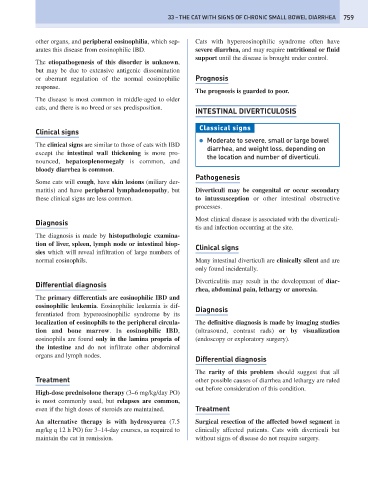Page 767 - Problem-Based Feline Medicine
P. 767
33 – THE CAT WITH SIGNS OF CHRONIC SMALL BOWEL DIARRHEA 759
other organs, and peripheral eosinophilia, which sep- Cats with hypereosinophilic syndrome often have
arates this disease from eosinophilic IBD. severe diarrhea, and may require nutritional or fluid
support until the disease is brought under control.
The etiopathogenesis of this disorder is unknown,
but may be due to extensive antigenic dissemination
or aberrant regulation of the normal eosinophilic Prognosis
response.
The prognosis is guarded to poor.
The disease is most common in middle-aged to older
cats, and there is no breed or sex predisposition.
INTESTINAL DIVERTICULOSIS
Classical signs
Clinical signs
● Moderate to severe, small or large bowel
The clinical signs are similar to those of cats with IBD
diarrhea, and weight loss, depending on
except the intestinal wall thickening is more pro-
the location and number of diverticuli.
nounced, hepatosplenomegaly is common, and
bloody diarrhea is common.
Pathogenesis
Some cats will cough, have skin lesions (miliary der-
matitis) and have peripheral lymphadenopathy, but Diverticuli may be congenital or occur secondary
these clinical signs are less common. to intussusception or other intestinal obstructive
processes.
Most clinical disease is associated with the diverticuli-
Diagnosis
tis and infection occurring at the site.
The diagnosis is made by histopathologic examina-
tion of liver, spleen, lymph node or intestinal biop-
Clinical signs
sies which will reveal infiltration of large numbers of
normal eosinophils. Many intestinal diverticuli are clinically silent and are
only found incidentally.
Diverticulitis may result in the development of diar-
Differential diagnosis
rhea, abdominal pain, lethargy or anorexia.
The primary differentials are eosinophilic IBD and
eosinophilic leukemia. Eosinophilic leukemia is dif-
Diagnosis
ferentiated from hypereosinophilic syndrome by its
localization of eosinophils to the peripheral circula- The definitive diagnosis is made by imaging studies
tion and bone marrow. In eosinophilic IBD, (ultrasound, contrast rads) or by visualization
eosinophils are found only in the lamina propria of (endoscopy or exploratory surgery).
the intestine and do not infiltrate other abdominal
organs and lymph nodes.
Differential diagnosis
The rarity of this problem should suggest that all
Treatment other possible causes of diarrhea and lethargy are ruled
out before consideration of this condition.
High-dose prednisolone therapy (3–6 mg/kg/day PO)
is most commonly used, but relapses are common,
even if the high doses of steroids are maintained. Treatment
An alternative therapy is with hydroxyurea (7.5 Surgical resection of the affected bowel segment in
mg/kg q 12 h PO) for 3–14-day courses, as required to clinically affected patients. Cats with diverticuli but
maintain the cat in remission. without signs of disease do not require surgery.

